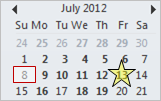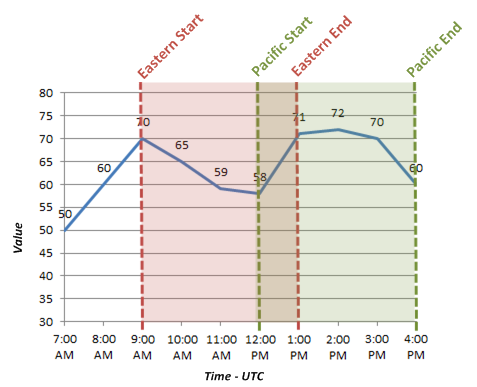
In the Properties window for some nodes, you can specify a date and time that should be used when evaluating values. For example, consider the following Properties window for a Collection Filter node that is configured to filter Measurement Location reading values to only those that were recorded in the past 7 days.

You can define specific date and time values in the standard format YYYY-MM-DD HH: mm: ss, where the time values use a 24-hour time format.
Alternatively, you can use a combination of acceptable values to specify dates and times that are relative to the time at which the policy is executed.
When using relative dates and times, the actual date and time that is evaluated depends on the date and time at which the policy is executed. For example, if you specify a relative date of Sunday, the GE Digital APM system will use the most recent Sunday (at 12:00:00 A.M. in the policy's time zone) relative to the date and time that the policy is being executed. So, if a policy is executed on Friday, July 13, the evaluated date would be Sunday, July 8, as illustrated in the image below, where:

You can adjust relative date and time values by adding operators and variables to the relative date:
For example, if you specify Sunday + 4 hours, the evaluated date will be 4:00:00 A.M. on the most recent Sunday.
The following table describes the constants that you can use to specify relative dates and times. Note that:
|
Constant |
Meaning |
|---|---|
|
Constants for Days |
|
|
*, start |
The day and time that the policy execution began. |
|
now |
The day and time that the specific node is executed. For example, policy execution might begin at 1:00:00 A.M., but a subsequent node may not be executed until 1:00:25 A.M. If now is specified in the subsequent node, the GE Digital APM system will use the time 1:00:25 A.M. |
|
t, today |
12:00 A.M. of the current day. |
|
y, yesterday |
12:00 A.M. of the previous day. |
|
Sun, Sunday |
12:00 A.M. of the most recent Sunday. |
|
Mon, Monday |
12:00 A.M. of the most recent Monday. |
|
Tue, Tuesday |
12:00 A.M. of the most recent Tuesday. |
|
Wed, Wednesday |
12:00 A.M. of the most recent Wednesday. |
|
Thu, Thursday |
12:00 A.M. of the most recent Thursday. |
|
Fri, Friday |
12:00 A.M. of the most recent Friday. |
|
Sat, Saturday |
12:00 A.M. of the most recent Saturday. |
|
Constants for Months |
|
|
Jan, January |
12:00 A.M. of the most recent January 1st. |
|
Feb, February |
12:00 A.M. of the most recent February 1st. |
|
Mar, March |
12:00 A.M. of the most recent March 1st. |
|
Apr, April |
12:00 A.M. of the most recent April 1st. |
|
May |
12:00 A.M. of the most recent May 1st. |
|
Jun, June |
12:00 A.M. of the most recent June 1st. |
|
Jul, July |
12:00 A.M. of the most recent July 1st. |
|
Aug, August |
12:00 A.M. of the most recent August 1st. |
|
Sep, September |
12:00 A.M. of the most recent September 1st. |
|
Oct, October |
12:00 A.M. of the most recent October 1st. |
|
Nov, November |
12:00 A.M. of the most recent November 1st. |
|
Dec, December |
12:00 A.M. of the most recent December 1st. |
The following table describes the variables you can use with relative dates. Note that these values are not localized, so you must enter them in English.
|
Variable |
Description |
Valid Number Type |
Example |
|---|---|---|---|
|
s, sec, second, seconds |
Adjusts the time by the specified number of seconds. |
Integer or decimal | 7 sec |
|
m, min, minute, minutes |
Adjusts the time by the specified number of minutes. |
Integer or decimal | 10 minutes |
|
h, hour, hours |
Adjusts the time by the specified number of hours. |
Integer or decimal | 6.5 h |
|
d, day, days |
Adjusts the time by the specified number of days. A day is interpreted as 24 hours and does not account for Daylight Savings Time. |
Integer | 1 day |
|
w, week, weeks |
Adjusts the time by the specified number of weeks. |
Integer |
3 w |
|
mo, month, months |
Adjusts the time by the specified number of months. |
Integer | 6 months |
|
y, year, years |
Adjusts the time by the specified number of years. |
Integer | 2 years |
|
[ddd].HH:MM:SS |
Adjusts the time by the specified time period. |
N/A |
15.12:15:35 |
When you specify a date and time that is relative to 12:00:00 A.M. of a specific day, the date range criteria and the policy time zone work together to determine the range of data that is included in the evaluation.
For example, suppose that you set up two policies to evaluate the exact same data, but one policy uses Eastern Time (UTC - 5) and the other uses Pacific Time (UTC - 8). If you specify that the policy should evaluate reading values starting at the relative time of today + 4 hours, the start time will be interpreted as 4:00:00 A.M., in the policy's time zone, of the current day. Because 4:00 A.M. Eastern Time occurs 3 hours earlier than 4:00 A.M. Pacific Time, each of those policies will end up evaluating a different set of data.
The following image illustrates this difference, where:

Copyright © 2018 General Electric Company. All rights reserved.